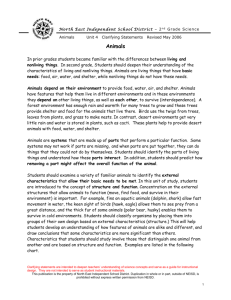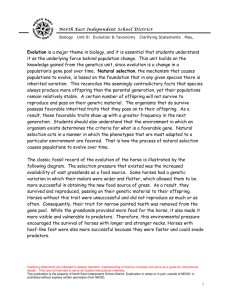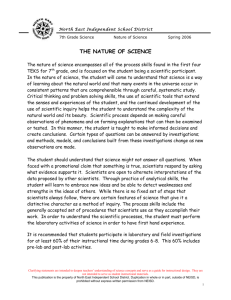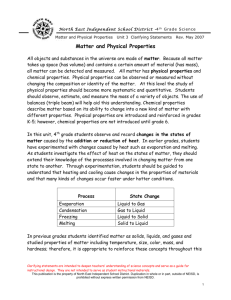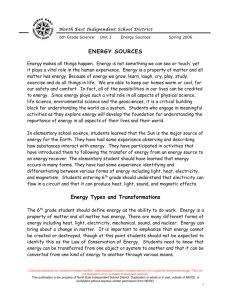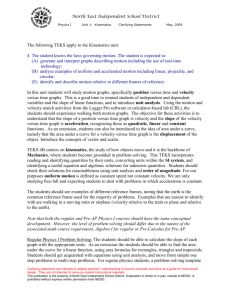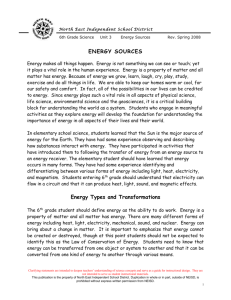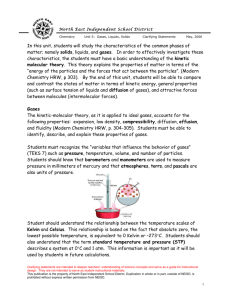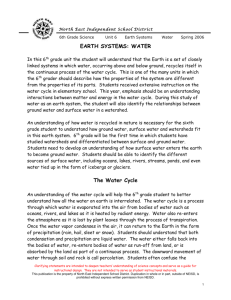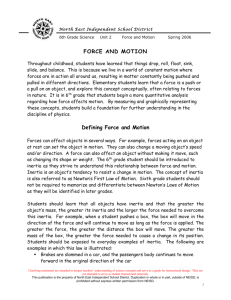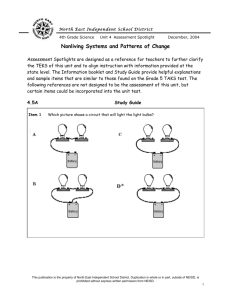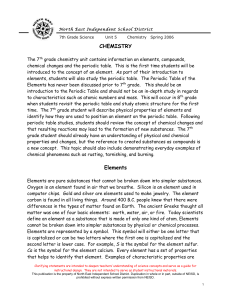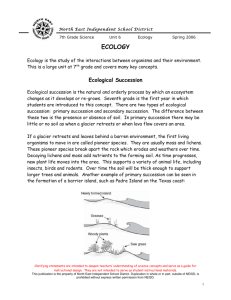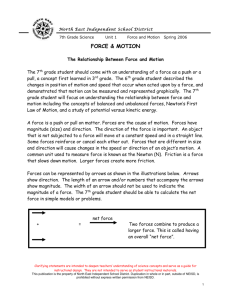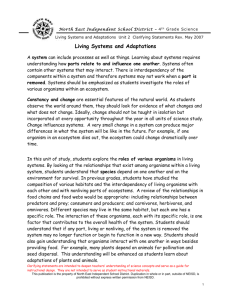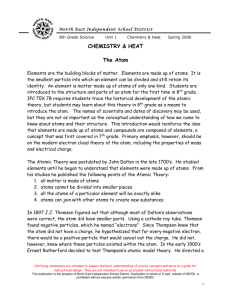Natural World - North East Independent School District
advertisement
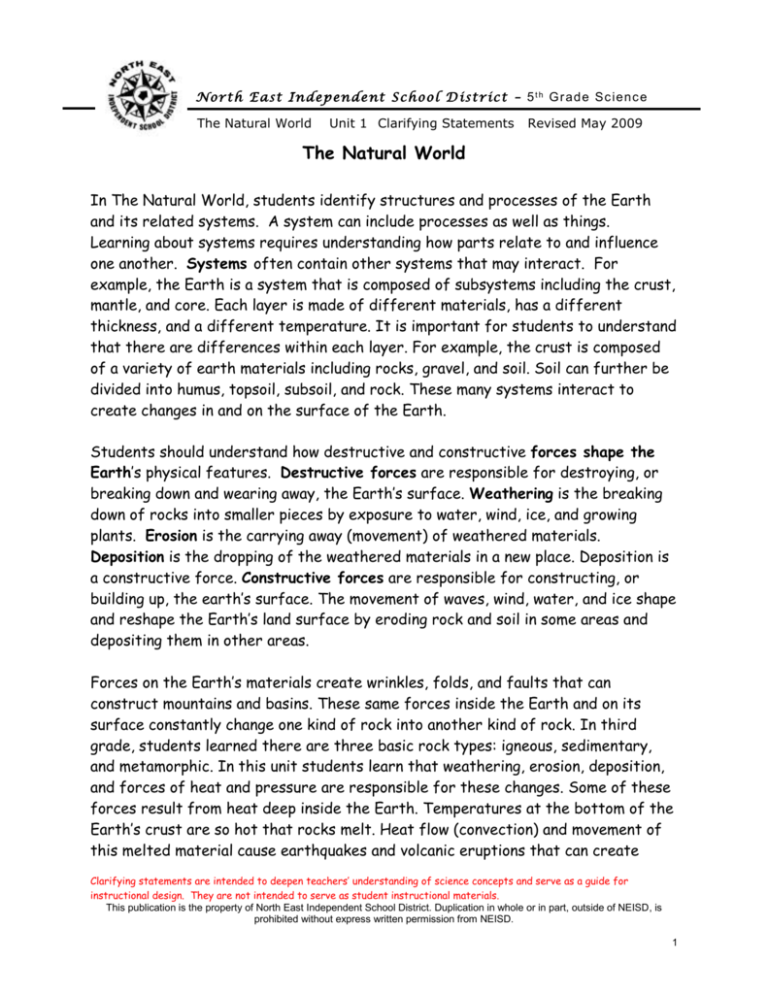
N o r t h E a st I n d ep en d e nt S c h o o l D i st ric t – 5 t h G r ad e Sc i enc e The Natural World Unit 1 Clarifying Statements Revised May 2009 The Natural World In The Natural World, students identify structures and processes of the Earth and its related systems. A system can include processes as well as things. Learning about systems requires understanding how parts relate to and influence one another. Systems often contain other systems that may interact. For example, the Earth is a system that is composed of subsystems including the crust, mantle, and core. Each layer is made of different materials, has a different thickness, and a different temperature. It is important for students to understand that there are differences within each layer. For example, the crust is composed of a variety of earth materials including rocks, gravel, and soil. Soil can further be divided into humus, topsoil, subsoil, and rock. These many systems interact to create changes in and on the surface of the Earth. Students should understand how destructive and constructive forces shape the Earth’s physical features. Destructive forces are responsible for destroying, or breaking down and wearing away, the Earth’s surface. Weathering is the breaking down of rocks into smaller pieces by exposure to water, wind, ice, and growing plants. Erosion is the carrying away (movement) of weathered materials. Deposition is the dropping of the weathered materials in a new place. Deposition is a constructive force. Constructive forces are responsible for constructing, or building up, the earth’s surface. The movement of waves, wind, water, and ice shape and reshape the Earth’s land surface by eroding rock and soil in some areas and depositing them in other areas. Forces on the Earth’s materials create wrinkles, folds, and faults that can construct mountains and basins. These same forces inside the Earth and on its surface constantly change one kind of rock into another kind of rock. In third grade, students learned there are three basic rock types: igneous, sedimentary, and metamorphic. In this unit students learn that weathering, erosion, deposition, and forces of heat and pressure are responsible for these changes. Some of these forces result from heat deep inside the Earth. Temperatures at the bottom of the Earth’s crust are so hot that rocks melt. Heat flow (convection) and movement of this melted material cause earthquakes and volcanic eruptions that can create Clarifying statements are intended to deepen teachers’ understanding of science concepts and serve as a guide for instructional design. They are not intended to serve as student instructional materials. This publication is the property of North East Independent School District. Duplication in whole or in part, outside of NEISD, is prohibited without express written permission from NEISD. 1 N o r t h E a st I n d ep en d e nt S c h o o l D i st ric t – 5 t h G r ad e Sc i enc e The Natural World Unit 1 Clarifying Statements Revised May 2009 landforms such as mountains and basins. Some changes in the Earth’s surface are abrupt (such as floods, mudslides, earthquakes, and volcanic eruptions) while other changes happen slowly over time (such as mountain building and delta formation). Past events have shaped present day land features. By studying or observing features such as sedimentary rock sequences, students can draw conclusions about what happened in the past. Each layer tells the history of the events that took place. In general the layers on the top tell about the most recent events and the layers on the bottom tell about the distant past. In between is the history from past to present. The layers do not tell exactly when an event took place or the complete story about the event, but they do tell the order in which some events took place. For example in this diagram of sedimentary rock layers, scientists can conclude that layer K is the oldest and layer N is the youngest. N M L K Clarifying statements are intended to deepen teachers’ understanding of science concepts and serve as a guide for instructional design. They are not intended to serve as student instructional materials. This publication is the property of North East Independent School District. Duplication in whole or in part, outside of NEISD, is prohibited without express written permission from NEISD. 2 N o r t h E a st I n d ep en d e nt S c h o o l D i st ric t – 5 t h G r ad e Sc i enc e The Natural World Unit 1 Clarifying Statements Revised May 2009 Scientists also use tree-growth rings to learn about the past. In general, each ring on a tree represents one year of growth. The widths differ due to changes in the climate and water availability. In the picture below, the thick, inner rings show conditions were favorable for tree growth, whereas the thin, outer rings indicate less favorable conditions. Using this information, scientists can conclude what the climate was like in the past. In previous grades, students identify, describe, and classify natural resources. In 5th grade, students should understand how past events have led to the formation of renewable, nonrenewable and inexhaustible resources. Renewable resources can be replenished over relatively short time spans and may include: plants and animals for food; natural fibers for clothing; soil for plant growth; and forest products for lumber and paper. Inexhaustible resources are renewable resources that are so vast that they cannot be used up in many lifetimes and include: water energy resulting from the effects of gravity, wind energy resulting from the uneven heating of the Earth by the sun, and solar energy. Nonrenewable resources are resources that continue to form; however, the processes that create them are so slow that significant deposits take millions of years to accumulate. These may include fossil fuels (such as natural gas, oil, and coal), metals (such as iron, aluminum, and copper), and minerals (such as quartz, graphite, and topaz). In addition, students describe the processes responsible for the formation of coal, oil, natural gas, and minerals. Coal forms when land plants in swamps and marshes become buried under layers of sediments. Oil and natural gas are formed from once living microorganisms that were buried under ancient seas. As the sedimentary layers build up, the pressure increases. This pressure coupled with Clarifying statements are intended to deepen teachers’ understanding of science concepts and serve as a guide for instructional design. They are not intended to serve as student instructional materials. This publication is the property of North East Independent School District. Duplication in whole or in part, outside of NEISD, is prohibited without express written permission from NEISD. 3 N o r t h E a st I n d ep en d e nt S c h o o l D i st ric t – 5 t h G r ad e Sc i enc e The Natural World Unit 1 Clarifying Statements Revised May 2009 heat from inside the Earth changes plant matter into coal and organic matter from ancient seas into oil and natural gas. A mineral is a solid natural material that has a crystal form and is made by nature in or on the Earth’s crust. Minerals form when molten rock cools and forms crystals or when water evaporates and leaves crystals behind. These minerals combine to create rocks. Three renewable resources, critical to all life on Earth, are carbon, nitrogen, and water. The Earth has a finite amount of these materials which are cycled (used and reused) through nature. The Earth has a limited capacity to absorb wastes and recycle materials naturally. The benefits of the Earth’s resources can be reduced by using them wastefully or destroying them. Therefore, to assure that these natural resources are available for use, conservation is essential. The carbon, nitrogen, and water cycles play a role in Earth’s systems. **Teacher note: The carbon, nitrogen, and water cycles are introduced in this unit of study as a method of recycling natural resources. Carbon is found in fossil fuels and is released back into the Earth system when these fuels are burned. Water is an agent of weathering and erosion; therefore it helps to shape Earth’s surface. Water is a renewable resource, recycled through the water cycle. Water flow is an inexhaustible resource. As long as gravity exists, water will flow. Nitrogen, water vapor, and carbon dioxide gases are also found in our atmosphere. It is not recommended to teach the cycles in their entirety during this unit. These cycles are a better fit in the Cycles and Adaptations unit. Clarifying statements are intended to deepen teachers’ understanding of science concepts and serve as a guide for instructional design. They are not intended to serve as student instructional materials. This publication is the property of North East Independent School District. Duplication in whole or in part, outside of NEISD, is prohibited without express written permission from NEISD. 4
